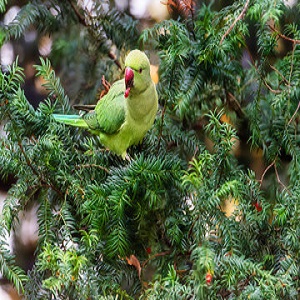Amazing facts about Alexandrine parakeets, with their vibrant plumage, charismatic personalities, and remarkable intelligence, hold a special place in the avian world. These captivating creatures have long been admired for their striking beauty and engaging behaviors. From their breathtaking array of colors to their ability to mimic human speech, alexandrine parakeets have fascinated and enchanted humans for centuries. In this exploration, we delve into the captivating realm of alexandrine parakeets, shedding light on their diverse species, natural habitats, intriguing behaviors, and the unique bond they share with humans. Join us on a journey to uncover the secrets and wonders of these magnificent avian companions – the alexandrine parakeets.
15 Amazing Facts About Alexandrine Parakeet!
1. The Fascinating World of Alexandrine parakeet
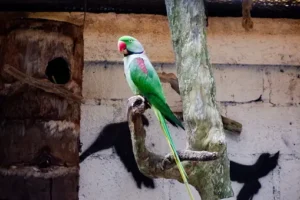
Dive into the captivating realm of alexandrine parakeets, where vibrant plumage, charming personalities, and remarkable intelligence converge. These avian wonders have enraptured humans for centuries, with their vivid colors and engaging behaviors. With an array of species inhabiting various corners of the globe, each with unique traits and adaptations, the world of alexandrine parakeets is a mesmerizing tapestry of biodiversity.
From lush rainforests to arid savannahs, alexandrine parakeets have carved out their niches, adapting to diverse environments with resilience and ingenuity. Their ability to mimic human speech and other sounds has further endeared them to us, sparking a timeless fascination.
In this exploration, we unravel the intricacies of alexandrine parakeets’ lives, their role in ecosystems, and their significance in human culture. Join us as we uncover the mysteries and enchantments of these extraordinary creatures, delving into their natural history, behaviors, and the conservation efforts aimed at preserving their irreplaceable presence in our world.
2.Unveiling the Beauty of Alexandrine Parakeets: A Comprehensive Guide
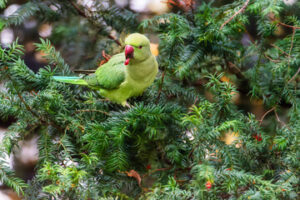
Alexandrine parakeets, with their resplendent plumage and captivating demeanor, stand as living canvases of nature’s artistic prowess. This comprehensive guide invites you to peer into the captivating world of these remarkable avian creatures, celebrated for their vivid colors, enchanting behaviors, and deep connections with humans.
Diverse in species and distributed across various habitats, alexandrine parakeets exhibit a stunning spectrum of colors that range from the lush greens of tropical rainforests to the vivid reds and blues of arid landscapes. Their vibrant feathers serve as both camouflage and communication, showcasing their uniqueness within the avian realm.
Beyond their visual allure, alexandrine parakeets exhibit remarkable intelligence and social intricacies. Their ability to mimic sounds, including human speech, has astounded observers for generations, fostering a bridge of communication between these feathered companions and their human counterparts.
This guide will take you on a journey through the natural habitats that alexandrine parakeets call home. From lush jungles to arid deserts, these adaptable creatures have established their presence across a variety of ecosystems, emphasizing their resilience and adaptability.
Join us as we delve into the captivating behaviors of alexandrine parakeets, exploring their complex social structures, nesting habits, and feeding rituals. Their interactions within their communities offer insight into avian society and the delicate balance of nature.
Moreover, this guide sheds light on the conservation efforts aimed at safeguarding alexandrine parakeet populations. Habitat loss and illegal trade pose significant threats, underscoring the urgency of collective action to protect these avian wonders for future generations.
Intriguing, enchanting, and at times elusive, alexandrine parakeets beckon us to appreciate the symphony of colors, sounds, and behaviors that define their existence. This comprehensive guide illuminates their world, inviting you to uncover the captivating beauty and inherent mysteries of these extraordinary creatures.
3. Alexandrine Parakeets: Colors, Behavior, and Characteristics
Alexandrine parakeets are a mesmerizing group of birds known for their vibrant colors, captivating behavior, and distinctive characteristics. Their stunning plumage comes alive in a spectrum of hues, from brilliant blues and radiant reds to lush greens and vibrant yellows. Beyond their visual splendor, alexandrine parakeets exhibit a wide range of behaviors that intrigue and entertain observers.
One of the most remarkable features of alexandrine parakeets is their intelligence. These avian wonders have displayed an impressive ability to mimic human speech and other sounds, often astonishing those who interact with them. Their social nature is evident in their strong bond with fellow flock members and their keen sense of communication through vocalizations and body language.
In their natural habitats, alexandrine parakeets are skilled navigators, using their strong beaks and agile feet to forage for food and create shelters in tree hollows. Their adaptability to various environments showcases their resilience and survival instincts. While some alexandrine parakeet species are solitary creatures, others thrive in large, raucous flocks, creating a captivating display of unity and cooperation.
Despite their beauty and charm, alexandrine parakeets face challenges in the form of habitat loss and the pet trade. Conservation efforts are crucial to safeguarding these remarkable creatures and preserving their role in ecosystems. Whether in the wild or as companions in human homes, alexandrine parakeets continue to enchant and inspire with their kaleidoscope of colors, fascinating behavior, and unique characteristics.
4. Captivating Alexandrine Parakeet Species from Around the Globe
Embarking on a global journey, we encounter an enchanting array of alexandrine parakeet species that grace various corners of the Earth with their striking presence. From the lush rainforests of South America to the arid landscapes of Australia, alexandrine parakeets showcase their dazzling colors and distinct characteristics.
In the heart of the Amazon rainforest, the Scarlet Macaw (Ara macao) reigns supreme with its brilliant scarlet and blue plumage. Meanwhile, the majestic Hyacinth Macaw (Anodorhynchus hyacinthinus) boasts the title of the largest parrot species, captivating onlookers with its cobalt blue feathers and playful antics.
Venturing Down Under, the vibrant Rainbow Lorikeet (Trichoglossus moluccanus) graces the skies of Australia with its multicolored palette, while the Kea (Nestor notabilia) of New Zealand stands out for its curious and mischievous nature.
The African continent introduces us to the African Grey Parrot (Psittacus erithacus), renowned for its exceptional cognitive abilities and aptitude for mimicry. Meanwhile, the Monk Parakeet (Myiopsitta monachus) makes its mark with its communal nesting habits and lively demeanor.
In Asia, the Indian Ring neck Parakeet (Psittacula krameri) showcases a spectrum of hues, captivating admirers with its distinctive ringed neck and lively disposition.
This global tour merely scratches the surface of the captivating alexandrine parakeet species found worldwide. Each one tells a unique story, adding to the rich tapestry of avian biodiversity that graces our planet. As we delve deeper into their world, we uncover not only their physical beauty but also the intricate roles they play in their respective ecosystems, reminding us of the fragile interconnectedness of life on Earth.
The 20 Most Amazing Birds In Virginia! (2023)
5. Exploring the Natural Habitat and Diet of Alexandrine Parakeets
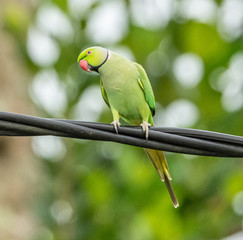
The natural habitat and diet of alexandrine parakeets offer a captivating insight into their evolutionary adaptations and ecological significance. These vibrant avian wonders are found in a diverse range of ecosystems, from lush rainforests to arid savannahs, showcasing their remarkable adaptability.
In their native habitats, alexandrine parakeets thrive on a diet that consists primarily of fruits, nuts, seeds, and vegetation. Their strong beaks are perfectly adapted for cracking open tough shells and extracting nutrient-rich content. This diet not only sustains them but also plays a crucial role in seed dispersal, aiding in the regeneration of plant species within their ecosystems.
Alexandrine parakeets are also known for their role as ecosystem engineers. Their feeding habits and interactions with plant life influence the landscape, shaping vegetation patterns and even creating nesting sites for other species. This demonstrates their intricate role in maintaining the delicate balance of their surroundings.
As habitats face challenges such as deforestation and climate change, understanding the natural habitat and dietary preferences of alexandrine parakeets becomes essential for their conservation. By preserving the ecosystems they call home and ensuring a steady supply of their preferred foods, we can contribute to the long-term survival of these magnificent creatures.
6. The Enigmatic Intelligence of Alexandrine Parakeets
The enigmatic intelligence of alexandrine parakeets has long intrigued scientists and enthusiasts alike. These avian marvels exhibit cognitive abilities that challenge our understanding of animal intelligence. Alexandrine parakeets, belonging to the Psittacidae family, demonstrate a remarkable capacity for problem-solving, social interaction, and communication.
One of the most astonishing features of their intelligence is their exceptional mimicry skills. Alexandrine parakeets can imitate a wide range of sounds, including human speech, environmental noises, and even other animals’ calls. This remarkable vocal dexterity not only showcases their adaptability but also underscores their ability to learn and process complex auditory information.
In addition to mimicry, alexandrine parakeets showcase problem-solving skills that hint at a deeper level of cognitive processing. They can manipulate objects, navigate intricate puzzles, and exhibit tool-using behaviors in their natural habitats. These actions suggest a high degree of cognitive flexibility and adaptability to changing environments.
Furthermore, the social dynamics of alexandrine parakeets highlight their intelligence in the context of interpersonal relationships. They form intricate social bonds, engage in cooperative activities, and display empathy towards one another. Their ability to understand and respond to the emotions of their fellow parrots demonstrates a level of emotional intelligence that continues to captivate researchers.
In conclusion, the enigmatic intelligence of alexandrine parakeets extends beyond their vibrant plumage and charming antics. Their mimicry prowess, problem-solving abilities, and complex social interactions paint a portrait of creatures that are not only adaptive but also possess a depth of cognitive understanding that invites us to explore the rich tapestry of avian intelligence.
7. Conservation Efforts for Preserving Alexandrine Parakeet Populations
Conservation efforts aimed at preserving alexandrine parakeet populations have become increasingly crucial in the face of habitat loss, illegal trade, and other threats. These colorful and intelligent avian species, often prized as pets or targeted for their vibrant feathers, are experiencing population declines in many parts of the world.
To address these challenges, numerous initiatives have been established. Habitat protection and restoration projects are vital components of conservation, focusing on preserving the natural environments where alexandrine parakeets thrive. Collaborative partnerships between local communities, governments, and conservation organizations are essential to ensure the long-term survival of these birds.
Efforts to combat the illegal pet trade involve stricter law enforcement and public awareness campaigns to discourage the purchase and possession of alexandrine parakeets as pets. Sustainable management practices, such as regulated breeding and trade, are being implemented to reduce the impact on wild populations.
Additionally, research plays a pivotal role in understanding alexandrine parakeet behavior, migration patterns, and breeding habits. This knowledge informs conservation strategies and helps identify priority areas for protection.
The road to preserving alexandrine parakeet populations is a multifaceted endeavor that demands collective action and global cooperation. Through these concerted efforts, we can work towards safeguarding these magnificent birds for future generations to appreciate and admire.
8. Alexandrine Parakeets as Exotic Pets: Considerations and Care
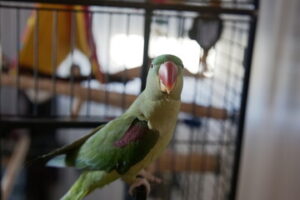
Alexandrine parakeets, renowned for their striking beauty and remarkable intelligence, are sought after as exotic pets by bird enthusiasts around the world. However, prospective owners must carefully consider the responsibilities and challenges that come with keeping these captivating creatures in a domestic setting.
First and foremost, the long lifespan of alexandrine parakeets must be acknowledged, as they can live for several decades. This commitment necessitates planning for their care throughout their entire lives. Their social nature requires regular interaction and mental stimulation, making companionship a vital aspect of their well-being.
Housing for alexandrine parakeets should be spacious and enriched, allowing for ample movement and mental engagement. Proper nutrition is crucial, as their diets often consist of a variety of fresh fruits, vegetables, nuts, and high-quality pellets. Adequate veterinary care is essential, including regular check-ups and specialized avian expertise.
Alexandrine parakeets’ innate ability to mimic sounds, including human speech, adds to their allure as pets. However, this vocal talent requires patience and consistent training to ensure a harmonious and non-disruptive household environment.
Potential owners should also be aware of legal and ethical considerations surrounding alexandrine parakeet ownership, particularly regarding species conservation and captive breeding programs.
20 Amazing Types Of Florida Beach Birds (With Pictures)
9. Alexandrine parakeets in Art and Culture: Symbolism and Representation
Alexandrine parakeets have left an indelible mark on art and culture, their vivid hues and charismatic demeanor making them a potent symbol across civilizations. In various societies, these birds symbolize attributes ranging from beauty and intelligence to mysticism and communication. In ancient civilizations like the Egyptians and Greeks, alexandrine parakeets were depicted in intricate artworks as emblems of luxury and prestige, adorning the lives of nobility.
In diverse cultures, alexandrine parakeets have become emblematic of communication and mimicry due to their astonishing ability to replicate human speech. They mirror the human desire for connection and understanding, underscoring their role as intermediaries between nature and mankind. This mimicry has sparked both amusement and intrigue, influencing folklore and oral traditions.
In Indigenous cultures, alexandrine parakeets often hold sacred significance, embodying spiritual wisdom and carrying messages between realms. Their resplendent feathers have been used in ceremonial regalia, enhancing their symbolic power. Additionally, alexandrine parakeets’ vibrant colors have inspired artistic expressions, evoking feelings of joy, vitality, and exoticism.
Through their portrayal in literature, paintings, and folklore, alexandrine parakeets continue to shape cultural narratives and artistic endeavors. Their presence in various forms of creative expression underscores the enduring fascination and reverence these birds command. As cultural icons, alexandrine parakeets illustrate the enduring interplay between humans and the natural world, enriching the tapestry of global heritage.
10. Alexandrine Parakeets: An Avian Wonder in the Wild
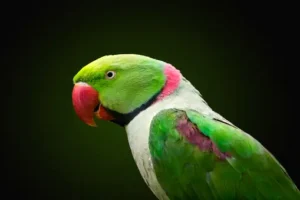
Alexandrine parakeets, a captivating and colorful group of birds, stand as avian wonders in the wild. With their vibrant plumage and charismatic personalities, they paint the skies with hues that range from brilliant blues and radiant reds to lush greens and dazzling yellows. These remarkable creatures inhabit diverse ecosystems across the globe, from lush rainforests to arid deserts, showcasing their adaptability and resilience.
Beyond their striking appearance, alexandrine parakeets exhibit exceptional intelligence and social behaviors. Their ability to mimic human speech and other sounds has long captured the imagination of people, making them sought-after companions and subjects of scientific study. Yet, despite their allure, alexandrine parakeets face various challenges in their natural habitats, including habitat loss and illegal wildlife trade.
In this exploration, we delve into the world of alexandrine parakeets, uncovering the intricacies of their lives, their vital roles within ecosystems, and the efforts being made to ensure their survival. Join us as we celebrate the avian marvel that is the alexandrine parakeet, a testament to the beauty and diversity of our natural world.
11. Alexandrine Parakeet Vocalizations: Calls, Mimicry, and Communication
Alexandrine parakeets are renowned for their intricate vocalizations, encompassing a wide range of calls, mimicry, and communication techniques. These avian virtuosos employ vocalizations not only for basic communication but also as a means of social interaction and survival.
Their repertoire includes an array of calls, each serving distinct purposes. Contact calls help maintain group cohesion, allowing parrots to locate and stay connected with one another in their often dense and complex habitats. Alarm calls alert the flock to potential threats, facilitating swift responses to danger. These vocal exchanges contribute to the intricate social dynamics within parrot communities.
Mimicry stands as one of the most captivating aspects of parrot vocalizations. Renowned for their ability to imitate various sounds, including human speech, parrots showcase their remarkable cognitive abilities. While the exact purpose of mimicry is not fully understood, it likely aids in establishing territory, attracting mates, or confusing predators.
Communication among alexandrine parakeets extends beyond vocalizations to include body language, gestures, and displays. Intricate courtship dances and feather puffing convey intentions, while specific movements help diffuse conflicts within the group.
Intriguingly, the propensity for mimicry has contributed to parrots becoming beloved companions for humans. Their capacity to mimic human speech has amused and amazed people for generations, forging a unique bond between these birds and their human admirers.
12. Ethical Considerations of Interacting with Alexandrine Parakeets
Ethical considerations surrounding interactions with alexandrine parakeets are paramount in ensuring their well-being and preservation. These intelligent and socially complex creatures deserve our respect and responsible care. Captive environments, such as homes or aviaries, must prioritize their physical and psychological needs. Adequate space, mental stimulation, and social interaction are essential for a healthy life.
The trade of wild-caught alexandrine parakeets raises significant ethical concerns, often involving habitat destruction and endangering native populations. Supporting legal and ethical breeding programs can help reduce the demand for wild-caught individuals.
Interacting with alexandrine parakeets should also emphasize their natural behaviors. Encouraging activities like foraging, flying, and problem-solving enhances their cognitive abilities and reduces potential stress-related behaviors. Positive reinforcement training methods foster trust and cooperation, ensuring a harmonious human-parrot relationship.
Responsible ownership entails a lifelong commitment. Prospective parrot guardians should thoroughly research the species’ specific needs and lifespan, ensuring they can provide appropriate care. Adoption from shelters and rescue organizations can be a compassionate choice, offering a loving home to parrots in need.
Ultimately, ethical interactions with alexandrine parakeets require a deep understanding of their innate behaviors, conservation status, and the commitment to provide a nurturing environment. By respecting their natural instincts and advocating for their protection, we contribute to the welfare of these magnificent beings in our shared world.
8 Outstanding Points About The Diet Of Baby Pigeons
13. Alexandrine Parakeets’ Role in Ecosystems and Biodiversity
Alexandrine parakeets play a crucial role in maintaining the health and balance of ecosystems, contributing significantly to biodiversity. These vibrant avian beings are not only visually captivating but also serve as important seed dispersers, helping to shape and regenerate plant communities within their native habitats.
As alexandrine parakeets forage for food, they consume a variety of fruits, nuts, and seeds from different plant species. In the process, they inadvertently aid in the propagation of plants by dispersing seeds across various locations. This behavior facilitates the growth of new vegetation, aids in forest regeneration, and enhances genetic diversity within plant populations.
Furthermore, alexandrine parakeets’ feeding habits and interactions with their environment can influence tree and plant species composition. By consuming specific fruits or seeds, they can impact the abundance of certain plant types, directly influencing the overall structure of ecosystems.
The conservation of alexandrine parakeet populations is crucial not only for the preservation of these captivating creatures but also for the preservation of the intricate web of life they support. Efforts to protect and restore their habitats ultimately contribute to maintaining the delicate balance of ecosystems and the diverse array of species that depend on them. As stewards of these remarkable birds, we hold a responsibility to safeguard their existence, ensuring the continued vitality of ecosystems and the biodiversity they sustain.
14. Alexandrine Parakeets: An Ancient Connection with Humans
For millennia, alexandrine parakeets have woven a tapestry of connection with humans, captivating our hearts and minds with their vivid hues and captivating behaviors. Across cultures and continents, these avian wonders have left an indelible mark, their presence deeply embedded in the annals of history.
From the lush rainforests of South America to the vast savannas of Africa and the dense forests of Southeast Asia, alexandrine parakeets have been both companions and symbols, revered for their beauty and revered in ancient lore. With their striking feathers and unparalleled mimicry, they’ve enchanted emperors and common folk alike.
Alexandrine parakeets have transcended mere pets, becoming ambassadors of communication between humans and the natural world. Ancient civilizations marveled at their ability to imitate human speech, leading to rich tales and legends that celebrated their unique talent. In some cultures, alexandrine parakeets symbolized wisdom, foresight, and divinity, serving as intermediaries between realms.
As trade routes expanded and cultures intertwined, alexandrine parakeets became coveted treasures, exchanged as gifts and symbols of diplomacy. Through their journey from rainforests to palaces, they carried messages of unity and harmony.
Today, as we continue to learn about and protect these remarkable creatures, the ancient connection between alexandrine parakeets and humans remains a testament to the enduring bond we share with the natural world. Their legacy endures, a testament to the timeless fascination and camaraderie between species separated by wings and words.
15. Mythology and Legends Surrounding Alexandrine Parakeets
Throughout history, they have woven themselves into the rich tapestry of human mythology and folklore. Revered for their striking beauty and uncanny abilities, these enchanting birds have captured the imagination of cultures around the world.
In ancient Indian mythology, alexandrine parakeets are believed to possess mystical qualities, symbolizing love and fidelity. Legends tell of parrots carrying messages of devotion between separated lovers, serving as messengers of the heart.
In Mesoamerican civilizations, alexandrine parakeets were revered as symbols of divinity and communication with the spirit world. They were thought to bridge the gap between the mortal realm and the heavens, with their vibrant plumage reflecting the colors of the gods.
They also found their place in Polynesian lore, where they were seen as messengers of the gods and bearers of wisdom. These birds were thought to hold the knowledge of the ages, whispering ancient secrets to those who could understand their language.
From ancient Greece to the distant islands of the Pacific, alexandrine parakeets have captivated cultures with their beauty and mystique, inspiring tales of love, spirituality, and wisdom. As they continue to grace our world with their presence, they remind us of the enduring power of nature to spark imagination and connect us to realms beyond our own.
What Does It Mean When You See A Cardinal? 5 Important Points
Diet of Alexandrine Parakeet
The diet of alexandrine parakeets is diverse and crucial to their well-being. These intelligent birds primarily feed on a range of fruits, seeds, nuts, and vegetation found in their natural habitats. Their diet often consists of berries, figs, apples, and other tropical fruits, providing essential vitamins and nutrients. Seeds, such as sunflower and safflower seeds, contribute to their energy needs.
<p>Alexandrine parakeets also consume various types of nuts, including almonds and walnuts, which offer healthy fats. In some cases, they may forage for flowers, buds, and leafy greens to supplement their diet. Adequate nutrition is vital to their vibrant plumage, reproductive success, and overall vitality. In captivity, a well-balanced diet of fresh fruits, vegetables, commercial pellets, and occasional treats supports their health and longevity, mimicking their natural dietary habits.
Diseases Of Alexandrine Parakeet
<div>
- Psittacosis (Parrot Fever): A bacterial infection caused by Chlamydia psittaci, psittacosis can lead to respiratory issues, fever, lethargy, and digestive problems in alexandrine parakeets. It’s a zoonotic disease that can also affect humans.
- Beak and Feather Disease: This viral infection affects the feathers, beak, and immune system of parrots, causing abnormal feather growth, loss, and beak deformities. It weakens the bird’s ability to fly and can lead to secondary infections.
- Aspergillosis: A fungal infection caused by Aspergillus species, this disease can affect the respiratory system of parrots, leading to breathing difficulties, coughing, and nasal discharge.
- Polyomavirus: Primarily affecting young parrots, polyomavirus can cause sudden death, regurgitation, lethargy, and weakness. It affects the gastrointestinal and circulatory systems.
- Macaw Wasting Disease (Proventricular Dilatation Disease – PDD): A viral disease that affects the nerves controlling the digestive system, PDD can lead to regurgitation, weight loss, and neurological symptoms in alexandrine parakeets.
- <strong>Avian Pox: A viral infection causing wart-like growths on the skin and inside the mouth, avian pox can lead to respiratory distress, difficulty eating, and general discomfort.
- Bacterial Infections: Bacteria such as E. coli, Salmonella, and others can cause digestive disturbances, diarrhea, and other health issues in alexandrine parakeets.
- <strong>Parasitic Infections: Internal and external parasites like mites, lice, and intestinal worms can compromise the health of alexandrine parakeets and lead to various symptoms.
Preventing these diseases involves providing a clean and safe environment, proper nutrition, regular veterinary care, quarantine procedures for new birds, and avoiding exposure to sick birds. Early detection and treatment are crucial for minimizing the impact of these diseases on alexandrine parakeets’ health.
tyle=”text-align: center;”>
Conclusion:
In conclusion, alexandrine parakeets stand as both exquisite avian wonders and cultural icons, bridging the realms of nature and human imagination. Their vibrant hues, intelligent mimicry, and storied roles in mythology attest to their enduring fascination. As we marvel at their beauty and delve into their captivating behaviors, alexandrine parakeets remind us of the profound interplay between the natural world and human storytelling, enriching our lives with their enchanting presence.
FAQ’s:
What makes alexandrine parakeets’ plumage so vibrant and colorful?</h4><p>Alexandrine parakeets’ dazzling colors are a result of specialized pigments in their feathers. These pigments, known as carotenoids, are derived from the foods they eat, such as fruits and vegetables, and contribute to their breathtaking array of hues.
2. Can alexandrin
e parakeets really mimic human speech?Yes, many alexandrine parakeet species are renowned for their ability to mimic human speech and other sounds. They have a unique vocal structure that allows them to imitate a wide range of sounds, making them exceptional communicators and captivating companions.
<h4>3. How do alexandrine parakeets adapt to their diverse habitats?</h4><p>Alexandrine parakeets have evolved remarkable adaptations to thrive in various ecosystems. Their strong beaks help them crack open tough nuts and fruits, while their agile feet allow them to navigate treetops with ease. Some species even build intricate nests in tree cavities, showcasing their resourcefulness.
4. Are all alexandrine parakeet species endangered?
While not all alexandrine parakeet species are endangered, many face threats due to habitat loss, illegal pet trade, and climate change.</p></p>
5. Do alexandrin
e parakeets have a significant cultural significance?</p>
Absolutely, ale
xandrine parakeets have left an indelible mark on cultures worldwide. They appear in ancient myths, symbolize love, wisdom, and spirituality, and have been kept as cherished pets. Their cultural importance serves as a testament to their enduring allure and their ability to captivate the human imagination.
Must Visit: Vetpomedix.com
